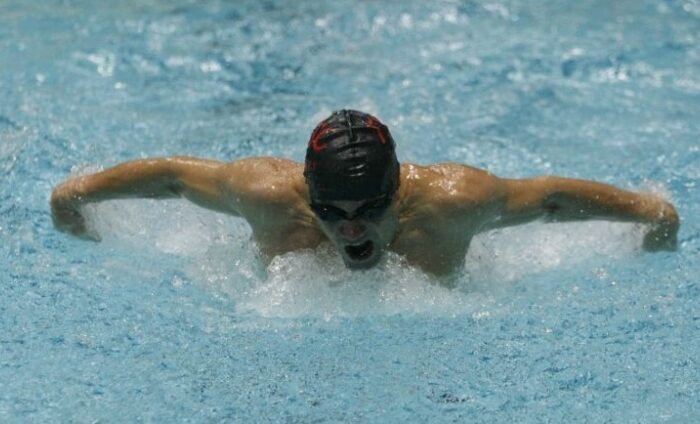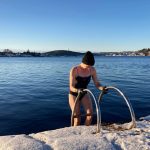
Tackling the 200m fly
Last year, along with lots of open water events, I decided to have a go at the 200m breaststroke at a couple of masters competitions, including the National Masters in November, where I finished sixth out of eight in my age group, a mere 16 seconds behind the winner. Breaststroke was always my least favourite stroke, and to race 200m of it is hard, but I had fun working on something different. It was good to get faster at something as I find increasing my front crawl speed ever more difficult.
This year, I decided to take on the fearsome 200m butterfly as my pool swimming challenge. Up until now, I think I’ve only done 200m fly once before, about 15 years ago, and I can still remember the pain of the final 50m and the almost total failure of my arms. However, knowing that some people can swim butterfly for hours inspired me to try again. After all, 200m fly should take less than the three minutes it takes me to cover the distance on breaststroke. Still, I had a genuine fear that I would be unable to complete the distance.
As I started practising, it quickly became obvious that the way I swam butterfly for a 50m sprint wouldn’t serve for 200m. It barely served for 100m as the few times I’ve raced that it felt like hitting a wall with 15m to go. I had to find a less energy intensive technique, so I took a look at how the long distance fly swimmers do it, with a pronounced pause at the front of the stroke while waiting for buoyancy to bring them back to the surface. However, I didn’t want to slow down too much so worked on a compromise that added in a short pause but kept forward momentum. I also shortened the push at the back of the stroke as I found that took a lot of energy and made the recovery part of the stroke harder.
The next challenge was to find enough space to practise. Ideally, in butterfly, as in front crawl, you should keep your eyes looking down with your head in a neutral position. As I’ve previously had neck problems, this was even more important, and I had to avoid lifting my head and looking forward when I breathed too. This makes it very difficult to see swimmers coming towards me. Ideally, I would have swum in a lane to myself, but where do you find one of those except in a race? Swimming butterfly in public sessions is often frowned upon – I’ve been asked to stop by the lifeguards more than once – so that left club sessions. The best way I found to practise was to add butterfly into front crawl training sets. For example, on a set of 8x100m FC, I would swim the first length of each 100m fly if I was leading the lane, or the final length of each if I was at the back (and I tried to avoid swimming in the middle). It wasn’t ideal, but it was a start. I also tried to do some longer distances on fly (50s, 75s and 100s) at the end of sessions when the lane thinned out. I thought practising butterfly when I was already tired would be a good idea!
My target event was Bracknell Masters on 3 March. In the final two weeks leading up to the swim I was having trouble with muscle spasms in my back so had to cut back the butterfly training. It was with some trepidation that I marked up my name to confirm I was going to swim and I considered pulling out several times. I don’t like sitting around waiting at galas (this is one of the reasons I prefer open water events) so I tend to enter more events than is good for me so I’ve got something to do. The 200m fly was the first event of the evening session. In the afternoon session I swam 200m freestyle, 50m backstroke and 100m breaststroke plus three 25m sprints in relays. I was tired before I even climbed on the block.
Somehow I ended up in the final and fastest heat. As the other swimmers raced ahead I kept reminding myself to take it steady. I kept focused on my feet as I have a tendency to flutter kick on butterfly, which would result in a disqualification. The first 100m went well, although I was pretty sure I was in last place. I also probably started too fast as lengths five and six felt ragged. I knew I was lifting my head too high to breathe and my stroke was too short, but I couldn’t do anything about it. But while most of the other swimmers were by now far ahead I noticed I was slowly gaining on one of them. This inspired me to attempt to pick up my pace for the final 50m although the splits show I actually slowed down at this point. The final 25m were a real struggle but I managed to keep my arms moving until the end. My chief emotion at this time was relief. I didn’t really care about the time. My first objective was to finish and I had done that. My second was not to get disqualified. I had a nervous few minutes waiting for the results to confirm that I hadn’t been.
Strangely, despite how hard 200m fly is, once I’d spent a few minutes recovering I felt great and shortly after managed to swim a decent time in the 100m freestyle.
I can’t see myself becoming a 200m butterfly specialist, but if you have a chance, I recommend giving it a go. It’s one of the toughest competitive events you can do (along with the 400m individual medley) and, like an open water swim, just completing it gives you a great sense of satisfaction. Practising butterfly will also help your freestyle and open water swimming.
Image thanks to www.dephoto.biz – this is me swimming butterfly but a couple of years ago at the National Masters in the 400m IM, not the 200m fly at Bracknell.








